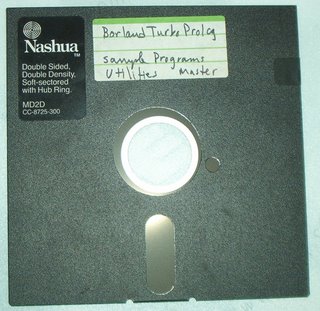
In 1975, Burroughs' plant in Glenrothes developed a prototype 5¼-inch drive, stimulated both by the need to overcome the larger 8-inch floppy's asymmetric expansion properties with changing humidity, and to reflect the knowledge that IBM's audio recording products division was demonstrating a dictation machine using 5¼-inch disks. In one of the industry's historic gaffes, Burroughs corporate management decided it would be "too inexpensive" to make enough money, and shelved the program. In 1976 two of Shugart Associates's employees, Jim Adkisson and Don Massaro, were approached by An Wang of Wang Laboratories, who felt that the 8-inch format was simply too large for the desktop word processing machines he was developing at the time. After meeting in a bar in Boston, Adkisson asked Wang what size he thought the disks should be, and Wang pointed to a napkin and said "about that size". Adkisson took the napkin back to California, found it to be 5¼-inches (13 cm) wide, and developed a new drive of this size storing 98.5 kB later increased to 110 kB by adding 5 tracks.[2] This is believed to be the first standard computer media that was not promulgated by IBM. The 5¼-inch drive was considerably less expensive than 8-inch drives from IBM, and soon started appearing on CP/M machines. At one point Shugart was producing 4,000 drives a day. By 1978 there were more than 10 manufacturers producing 5¼-inch floppy drives, in competing physical disk formats: hard-sectored (90 kB) and soft-sectored (110 kB). The 5¼-inch formats quickly displaced the 8-inch from most applications, and the 5¼-inch hard-sectored disk format eventually disappeared. These early drives read only one side of the disk, leading to the popular budget approach of cutting a second write-enable slot and index hole into the carrier envelope and flipping it over (thus, the "flippy disk") to use the other side for additional storage. introduced a double-sided drive in 1978, doubling the capacity, and a new "double density" format increased it again, to 360 kB.[3] For most of the 1970s and 1980s the floppy drive was the primary storage device for microcomputers. Since these micros had no hard drive, the OS was usually booted from one floppy disk, which was then removed and replaced by another one containing the application. Some machines using two disk drives (or one dual drive) allowed the user to leave the OS disk in place and simply change the application disks as needed. In the early 1980s, 96 track-per-inch drives appeared, increasing the capacity from 360 to 720 kB.[4] These did not see widespread use, as they were not supported by IBM in its PCs. (Another oddball format was used by Digital Equipment Corporation's Rainbow-100, DECmate-II and Pro-350. It held 400 kB[5] on a single side by using 96 tracks-per-inch and cramming 10 sectors per track.) Front and back of a floppy with a write-protect tab Despite the available capacity of the disks, support on the most popular operating system of the early 80's—PC-DOS and MS-DOS—lagged slightly behind. In fact, the original IBM PC did not include a floppy drive at all as standard equipment—you could either buy the optional 5¼-inch floppy drive or rely upon the cassette port. With version 1.0 of DOS (1981) only single sided 160 kB floppies were supported. Version 1.1 the next year saw support expand to double-sided, 320 kB disks. Finally in 1983 DOS 2.0 supported 9 sectors per track rather than 8, for a total of 360 kB of disk space.[6] Along with this change came support for different directories on the disk (now commonly called folders), which came in handy when organizing the greater number of files possible in this increased space. In 1984, along with the IBM PC/AT, the quad density disk appeared, which used 96 tracks per inch combined with a higher density magnetic media to provide 1200 kiB[7] of storage (formerly referred to as 1.2 megabytes). Since the usual (very expensive) hard disk held 10–20 megabytes at the time, this was considered quite spacious. By the end of the 1980s, the 5¼-inch disks had been superseded by the 3½-inch disks. Though 5¼-inch drives were still available, as were disks, they faded in popularity as the 1990s began. The main community of users was primarily those who still owned '80s legacy machines running MS-DOS that had no 3½-inch drive; the advent of Windows 95 (not even sold in stores in a 5¼-inch version; a coupon had to be obtained and mailed in) and subsequent phaseout of standalone MS-DOS with version 6.22 forced many of them to upgrade their hardware. On most new computers the 5¼-inch drives were optional equipment. By the mid-1990s the drives had virtually disappeared as the 3½-inch disk became the preeminent floppy disk.

No comments:
Post a Comment